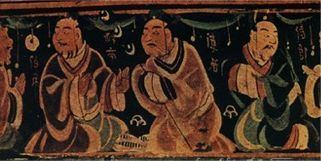Traditional Chinese 樂浪郡 Hanyu Pinyin Hanja 樂浪郡 | Simplified Chinese 乐浪郡 Hangul 낙랑군락랑군 | |
 | ||
Revised Romanization Nangnang-gunRangnang-gun | ||
Lelang commandery
Lelang was one of the Chinese commanderies which was established after the fall of Wiman Joseon in 108 BC until Goguryeo conquered it in 313. Though disputed by North Korean scholars, Western sources generally describe the Lelang Commandery as existing within the Korean peninsula, and extend the rule of the four commanderies as far south as the Han River (Korea). However, South Korean scholars assumed its administrative areas to Pyongan and Hwanghae region.
Contents
History
In 108 BC, Emperor Wu of the Han dynasty conquered the area under King Ugeo, a grandson of King Wiman. The Emperor set up Lelang, Lintun, Xuantu and Zhenfan, known as the Four Commanderies of Han in the northern Korean peninsula and Liaodong peninsula. The Book of Han records Lelang belonged to Youzhou, located in northwestern Gojoseon consisted of 25 prefectures, 62,812 houses, and the population was 406,748. Its capital was located Nakrang-guyok, P'yŏngyang. (Rakrang 樂浪/락랑 is a district in central P'yŏngyang today.)
After Emperor Wu's death, Zhenfan and Lintun were abolished and Xuantu was moved to Liaodong. Some prefectures of the abolished commanderies were incorporated into Lelang. Lelang after the consolidation is sometimes called "Greater Lelang commandery". Since Lelang became too large, the Defender of the Southern Section (南部都尉) was set up to rule the seven prefectures which formerly belonged to Zhenfan. Before that, the Defender of the Eastern Section (東部都尉) was set up to rule former Lintun's seven prefectures.
Immigrants mainly from Yan and Qi settled in the former Gojoseon lands and brought with them Chinese culture. Among them, the Wang clan, whose ancestor is said to have fled there from Qi in the 2nd century BC, became powerful.
While the Han dynasty was taken over by Wang Mang, Wang Tiao (王調) started a rebellion and tried to secede from China. In 30 AD, the rebellion was stopped by Wang Zun (王遵), whom Emperor Guangwu appointed as governor. Lelang came under the direct control of China once again. However, the shortage of human resources caused by the turmoil resulted in the abolishment of the seven eastern prefectures. The administration was left to the Hui (濊) natives, whose chiefs were conferred as marquises.
At the end of the Eastern Han dynasty, Gongsun Du, appointed as the Governor of Liaodong in 184, extended his semi-independent domain to the Lelang and Xuantu commanderies. His son Gongsun Kang separated the southern half from the Lelang commandery and established the Daifang commandery in 204. As a result, the Lelang commandery reverted to its original size.
In 236, under the order of Emperor Ming of Cao Wei, Sima Yi crushed the Gongsun family and annexed Liaodong, Lelang and Daifang to Wei. Sima Yi did not encourage frontier settlers to continue their livelihoods in the Chinese northeast and instead ordered households who wished to return to coastal and central China to do so, evacuating the region of Chinese settlers. The Jin Shu records the number of households in the Korean commanderies of Lelang and Daifeng as 8,600 households, less than a sixth of the figures given in the Hou Han Shu for Lelang (which included Daifeng). Liaodong would be out of Chinese hands for centuries due to the lack of Chinese presence there as a result of the policies the Wei court adopted for the commanderies after the fall of the Gongsun family.
Lelang was then inherited by the Jin dynasty. Due to bitter civil wars, Jin was unable to control the Korean peninsula at the beginning of the 4th century and was no longer able to dispatch officials to the frontier commanderies, which were maintained by the dwindling local population of remaining Han Chinese residents. The Zizhi Tongjian states that Zhang Tong (張統) of Liaodong, Wang Zun (王遵) of Lelang and over one thousand households decided to break away from Jin and submit to the Xianbei warlord of Former Yan Murong Hui. Murong Hui relocated the remnants of the commandery to the west within Liaodong. Goguryeo annexed the former territory of Lelang in 313. Goguryeo ended China's rule on the Korean peninsula by conquering Lelang in 313. After Lelang's fall, some commandery residents may have fled south to the indigenous Han polities there, bringing with them their culture that spread to the southern part of the Korean peninsula. With the collapse of the commanderies after four centuries of Chinese rule, Goguryeo and the native polities in the south that became Baekje and Silla began to grow and develop rapidly, heavily influenced by the culture of the Four Commanderies of Han.
Goguryeo absorbed much of what was left of Lelang through its infrastructure, economy, local inhabitants, and advanced culture. Unable to govern the region directly and form a new political center immediately, Goguryeo began to consolidate authority by replacing previous government administrators with its own appointed officials, mostly refugees and exiles from China, the most famous being Dong Shou (冬壽) who was entombed at Anak Tomb No. 3, overtly retaining the previous administrative system of Lelang. In 334 Goguryeo established the fortress and city of Pyongyang-song within the center of the former commandery. Towards the end of the 4th century, in order to focus on the growing threat of Baekje and having checked the power of Former Yan in Liaodong, Goguryeo began to actively strengthen and govern the city. In 427 Goguryeo moved its capital to Pyongyang from its former capital of Ji'an as the new political center of the kingdom in order to administer its territories more effectively.
